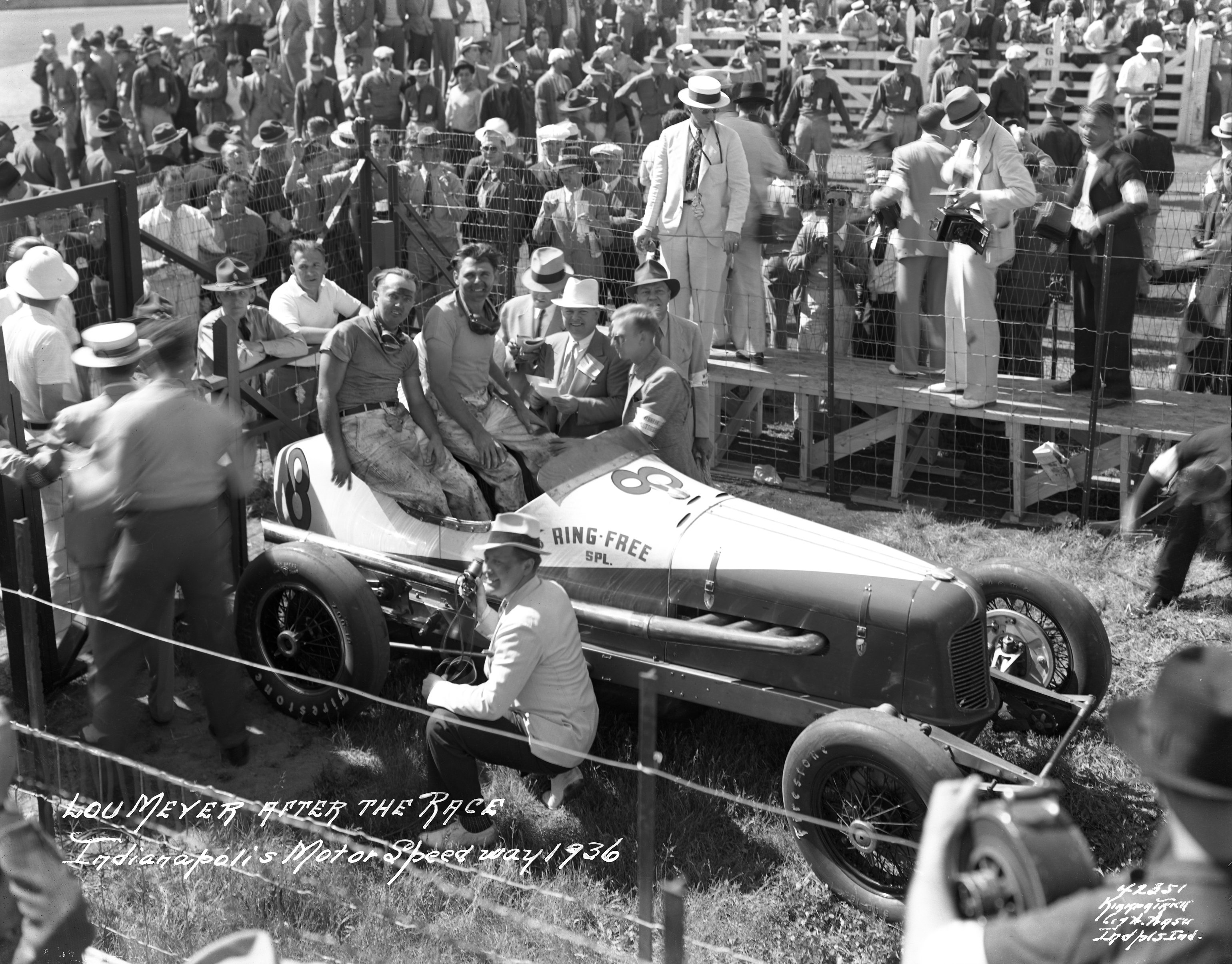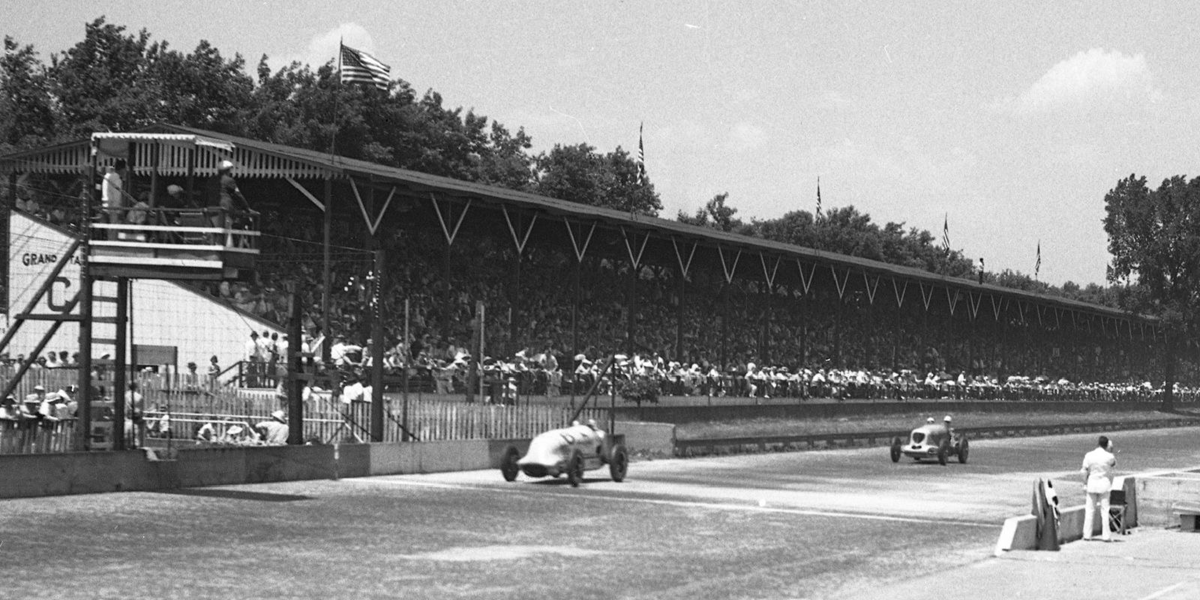1909
1909
1909
1910s
1910s
1920s
1920s
1930s
1930s
1940s
1940s
1950s
1950s
1960s
1960s
1970s
1970s
1980s
1980s
1990s
1990s
2000s
2000s
2010s
2010s
2020
2020





02/18/2009
Jimmy Dunham Centennial Era Moment
VIDEO










LOOK BOOK

READ MORE
04/03/2020
When race fans think of dominant drivers of the Indianapolis 500, they likely think of A.J. Foyt in the 1960s...
Shaw Writes History with Amazing Indy 500 Success
ARTICLE
On a blazing hot day, the Indianapolis 500 came down to which of two drivers could carry the most momentum off Turn 4...
04/01/2020
READ MORE
A FINISH FOR THE AGES: 1937 INDIANAPOLIS 500
ARTICLE
1930s ALMANAC
Dario Resta, driving a Peugeot, won the 1916 Indianapolis Classic, which, partially due to conservation efforts toward the war in Europe...

ARTICLE
02/11/2020
Navigating World War I
READ MORE
READ MORE
1930: After more than a decade of domination by purpose-built racing cars, a considerably revised set of specifications was now in effect in an attempt to encourage the return of America’s automobile manufacturers...
03/31/2020
The Indy 500 Year-by-Year
ARTICLE

IMS HISTORIAN DONALD DAVIDSON
DIGITAL DONALD

The entire track, except for several hundred yards of the main straight-away, was by now resurfaced with asphalt.
1939
Louis Meyer became the first driver to win three Indianapolis 500-Mile Races. He requested a bottle of buttermilk in Victory Lane, creating the inspiration for the winner to drink milk, an annual tradition since 1956.
1936
The Indianapolis Motor Speedway was the first track in the world to install safety warning lights. Also, helmet use became mandatory at IMS, a first for motor racing worldwide.
1935
Experience the decade that sparked Indy 500
traditions race fans love today.
1930s


IMS DIGITAL ARCHIVE


03/23/2020
1932 Newsreel Centennial Era Moment
VIDEO
03/23/2020
1939 Newsreel Centennial Era Moment
VIDEO





02/21/2020
1932 Newsreel Centennial Era Moment
VIDEO



Lorem ipsum dolor.
AUDIO
In the early days of the Indianapolis 500 presented by Gainbridge, then known as the International 500-Mile Sweepstakes...
04/03/2020
Firestone Tires Went the Distance
READ MORE
ARTICLE
On a blazing hot day, the Indianapolis 500 came down to which of two drivers could carry the most momentum off Turn 4 on Lap 200...
04/01/2020
A FINISH FOR THE AGES: 1937 INDIANAPOLIS 500
READ MORE
ARTICLE

LOOK BOOK
1930s ALMANAC
THE INDY 500 YEAR-BY-YEAR

DIGITAL DONALD

IMS HISTORIAN DONALD DAVIDSON
The entire track, except for several hundred yards of the main straightaway, was by now resurfaced with asphalt.
1939
Louis Meyer became the first driver to win three Indianapolis 500-Mile Races. He requested a bottle of buttermilk in Victory Lane, creating the inspiration for the winner to drink milk, an annual tradition since 1956.
1936
The Indianapolis Motor Speedway was the first track in the world to install safety warning lights. Also, helmet use became mandatory at IMS, a first for motor racing worldwide.
1935
The “Roaring Twenties” brought increased speeds and many “firsts” to IMS.
1920s

10/10
The start of the 1939 Indianapolis 500 as the field of 33 drives off the bricks on the main straightaway and onto the fresh asphalt that was paved onto portions of the Indianapolis Motor Speedway for the first time.
9/10
Indianapolis Motor Speedway legend Wilbur Shaw after winning his first Indianapolis 500 in 1937. Shaw had one of the most successful runs as a driver ever in the Indianapolis 500. In 1933 and 1935, Shaw finished second. Then, from 1937-1940, Shaw finished first, second, first and first, respectively.
8/10
1936 was a year of another “first.” The iconic Borg-Warner Trophy made its debut that year and was presented to the winner of the Indianapolis 500, Louis Meyer. The trophy has been presented to each winner, with their face engrained in the trophy, ever since.
7/10
6/10
Louis Meyer pulls into Victory Circle in 1936, then located near the end of the main straightaway, after becoming the first driver ever to win the Indianapolis 500-Mile race three times. Meyer completed the race in record time, with an average speed of 109.069 mph.
5/10
The 1935 Indianapolis 500 pole sitter Rex Mays. That year, Mays became the youngest pole sitter at age 22, a record that still stands to this day.
4/10
The revolutionary diesel-powered vehicle entered by the Cummins Engine Company of nearby Columbus, Indiana, and driven by Dave Evans in 1931. The car weighed almost 3,400 pounds and was a combination of a diesel truck engine mounted in a special Duesenberg chassis. Evans completed the 500 miles about 37 minutes after winner Louis Schneider, and he did so without making a single pit stop.
1930 Indianapolis 500 winner Billy Arnold works on his winning No. 4 machine. The 24-year-old led a record 198 of 200 laps on his way to victory that year. Arnold would go on to lead another 212 laps between the following two 500-mile races in 1931 and 1932. From 1930-1932, Arnold led 97.4% of the 421 laps he completed.
3/10
The view of pit lane prior to the start of the 1930
Indianapolis 500, looking to the south end of the racetrack and Turns 1 and 2.
2/10
1/10
A crowd gathers around Victory Circle near the south end of the racetrack, just off the main straightaway by Turn 1.








02/25/2009
1932 Newsreel Centennial Era Moment
VIDEO
In the early days of the Indianapolis 500 presented by Gainbridge, then known as the International 500-Mile Sweepstakes...
04/03/2020
Firestone Tires Went the Distance
READ MORE
ARTICLE
On a blazing hot day, the Indianapolis 500 came down to which of two drivers could carry the most momentum off Turn 4 on Lap 200...
04/01/2020
A FINISH FOR THE AGES: 1937 INDIANAPOLIS 500
READ MORE

ARTICLE
LOOK BOOK

1930s ALMANAC
The indy 500 year-by-year

IMS HISTORIAN DONALD DAVIDSON
DIGITAL DONALD

The entire track, except for several hundred yards of the main straightaway, was by now resurfaced with asphalt.
1939
Louis Meyer became the first driver to win three Indianapolis 500-Mile Races. He requested a bottle of buttermilk in Victory Lane, creating the inspiration for the winner to drink milk, an annual tradition since 1956.
1936
The Indianapolis Motor Speedway was the first track in the world to install safety warning lights. Also, helmet use became mandatory at IMS, a first for motor racing worldwide.
1935
1920s

The “Roaring Twenties” brought increased speeds and many “firsts” to IMS.

1909
1909
1909
1910s
1910s
1920s
1930s
1930s
1940s
1940s
1950s
1950s
1960s
1960s
1970s
1970s
1980s
1990s
2000s
2010s
2020

10/10
The start of the 1939 Indianapolis 500 as the field of 33 drives off the bricks on the main straightaway and onto the fresh asphalt that was paved onto portions of the Indianapolis Motor Speedway for the first time.
9/10
A view of the 1928 Indianapolis 500 from the pits, with the crowd watching the 500-mile spectacle behind them. The pits in the early days of the Indy 500 are notably different than today, with not even a wall separating the track from the pits.
8/10
1936 was a year of another “first.” The iconic Borg-Warner Trophy made its debut that year and was presented to the winner of the Indianapolis 500, Louis Meyer. The trophy has been presented to each winner, with their face engrained in the trophy, ever since.
7/10
6/10
Louis Meyer pulls into Victory Circle in 1936, then located near the end of the main straightaway, after becoming the first driver ever to win the Indianapolis 500-Mile race three times. Meyer completed the race in record time, with an average speed of 109.069 mph.
5/10
The 1935 Indianapolis 500 pole sitter Rex Mays. That year, Mays became the youngest pole sitter at age 22, a record that still stands to this day.
4/10
The revolutionary diesel-powered vehicle entered by the Cummins Engine Company of nearby Columbus, Indiana, and driven by Dave Evans in 1931. The car weighed almost 3,400 pounds and was a combination of a diesel truck engine mounted in a special Duesenberg chassis. Evans completed the 500 miles about 37 minutes after winner Louis Schneider, and he did so without making a single pit stop.
1930 Indianapolis 500 winner Billy Arnold works on his winning No. 4 machine. The 24-year-old led a record 198 of 200 laps on his way to victory that year. Arnold would go on to lead another 212 laps between the following two 500-mile races in 1931 and 1932. From 1930-1932, Arnold led 97.4% of the 421 laps he completed.
3/10
The view of pit lane prior to the start of the 1930 Indianapolis 500, looking to the south end of the racetrack and Turns 1 and 2.
2/10
1/10
A crowd gathers around Victory Circle near the south end of the racetrack, just off the main straightaway by Turn 1.





02/18/2009
Jimmy Dunham Centennial Era Moment
VIDEO
02/25/2009
1939 Newsreel Centennial Era Moment
VIDEO
02/21/2020
Jimmy Dunham Centennial Era Moment
VIDEO
02/21/2020
1939 Newsreel Centennial Era Moment
VIDEO

























10/10
The start of the 1939 Indianapolis 500 as the field of 33 drives off the bricks on the main straightaway and onto the fresh asphalt that was paved onto portions of the Indianapolis Motor Speedway for the first time.
9/10
Indianapolis Motor Speedway legend Wilbur Shaw after winning his first Indianapolis 500 in 1937. Shaw had one of the most successful runs as a driver ever in the Indianapolis 500. In 1933 and 1935, Shaw finished second. Then, from 1937-1940, Shaw finished first, second, first and first, respectively.
8/10
1936 was a year of another “first.” The iconic Borg-Warner Trophy made its debut that year and was presented to the winner of the Indianapolis 500, Louis Meyer. The trophy has been presented to each winner, with their face engrained in the trophy, ever since.
7/10
6/10
Louis Meyer pulls into Victory Circle in 1936, then located near the end of the main straightaway, after becoming the first driver ever to win the Indianapolis 500-Mile race three times. Meyer completed the race in record time, with an average speed of 109.069 mph.
5/10
The 1935 Indianapolis 500 pole sitter Rex Mays. That year, Mays became the youngest pole sitter at age 22, a record that still stands to this day.
4/10
The revolutionary diesel-powered vehicle entered by the Cummins Engine Company of nearby Columbus, Indiana, and driven by Dave Evans in 1931. The car weighed almost 3,400 pounds and was a combination of a diesel truck engine mounted in a special Duesenberg chassis. Evans completed the 500 miles about 37 minutes after winner Louis Schneider, and he did so without making a single pit stop.
1930 Indianapolis 500 winner Billy Arnold works on his winning No. 4 machine. The 24-year-old led a record 198 of 200 laps on his way to victory that year. Arnold would go on to lead another 212 laps between the following two 500-mile races in 1931 and 1932. From 1930-1932, Arnold led 97.4% of the 421 laps he completed.
3/10
The view of pit lane prior to the start of the 1930 Indianapolis 500, looking to the south end of the racetrack and
Turns 1 and 2.
2/10
1/10
A crowd gathers around Victory Circle near the south end of the racetrack, just off the main straightaway by Turn 1.








































Floyd Roberts celebrates after winning the 1938 Indianapolis 500. Roberts completed the race at a record average speed pace that would stand for 10 years: 117.200 mph.

Floyd Roberts celebrates after winning the 1938 Indianapolis 500. Roberts completed the race at a record average speed pace that would stand for 10 years: 117.200 mph.

Floyd Roberts celebrates after winning the 1938 Indianapolis 500. Roberts completed the race at a record average speed pace that would stand for 10 years: 117.200 mph.
IMS DIGITAL ARCHIVE




IMS DIGITAL ARCHIVE


1909
1909
1909
1910s
1910s
1920s
1920s
1930s
1930s
1940s
1940s
1950s
1950s
1960s
1960s
1970s
1970s
1980s
1990s
2000s
2010s
2020
